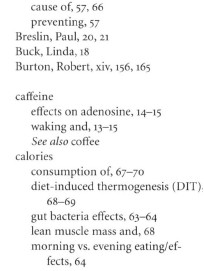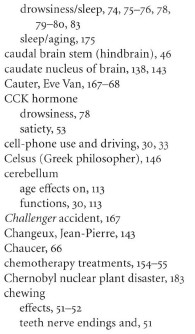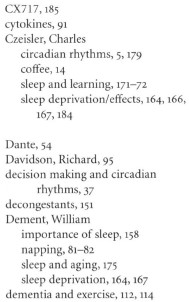Sex Sleep Eat Drink Dream (39 page)
Read Sex Sleep Eat Drink Dream Online
Authors: Jennifer Ackerman

[>]
Not much was known about past patterns:
A. Roger Ekirch,
At Day's Close
(New York: Norton, 2005).
The habit of sleeping in bouts:
I. Tobler, "Napping and polyphasic sleep in mammals," in D. F. Dinges and R. J. Broughton, eds.,
Sleep and Alertness: Chronobiological, Behavioral, and Medical Aspects of Napping
(New York: Raven Press, 1989), 9–30.
Thomas Wehr ... once devised an experiment:
T. A. Wehr, "In short photoperiods, human sleep is biphasic,"
Journal of Sleep Research
1:2, 103–7 (1992).
[>]
scientists at Vanderbilt University showed:
H. Ohta et al., "Constant light desynchronizes mammalian clock neurons,"
Nature Neuroscience
8:3, 267–69 (2005).
[>]
In turning on lamps and lights:
J. M. Zeitzer et al., "Temporal dynamics of late-night photic stimulation of the human circadian timing system,"
American Journal of Physiology: Regulatory, Integrative, and Comparative Physiology
289:3, R839–44 (2005).
Exposure to even low light levels:
D. B. Boivin et al., "Dose-response relationships for resetting of human circadian clock by light,"
Nature
379, 540–42 (1996).
Charles Czeisler's team has found:
S. B. S. Khalsa et al., "A phase response curve to single bright light pulses in human subjects,"
Journal of Physiology
549 (Pt. 3): 945–52 (2003); J. M. Zeitzer et al., "Sensitivity of the human circadian pacemaker to nocturnal light: melatonin phase resetting and suppression,"
Journal of Physiology
526:3, 695–702 (2000).
Even brief exposure to light:
J. A. Gastel, "Melatonin production: prote-asomal proteolysis in serotonin N-acetyltransferase regulation,"
Science
279, 1358–60 (1998).
When you fly halfway around the world:
C. Dunlop and J. Cortazar in
Los Autonautas de la Cosmopista 0 un Viage Atemporal (1983),
quoted in Russell Foster and Leon Kreitzman,
Rhythms of Life
(London: Profile Books, 2004), 201.
[>]
In one study, Menaker and his colleagues:
S. Yamazaki et al., "Resetting central and peripheral circadian oscillators in transgenic rats,"
Science
288, 682 (2000); personal communication with Michael Menaker, March 2005.
inspired by his own jet lag symptoms:
Kwangwook Cho, "Chronic 'jet lag' produces temporal lobe atrophy and spatial cognitive deficits,"
Nature Neuroscience
4:6, 567–68 (2001); K. Cho et al., "Chronic jet lag produces cognitive deficits,"
Journal of Neuroscience
20, RC66 (2000).
[>]
some
15
percent of the U.S. workforce:
Bureau of Labor Statistics, "Workers on flexible and shift schedules in 2004 summary,"
www.bls.gov/news.release/flex.nro.htm,
retrieved October 16, 2006.
To flesh out the effects:
J. Arendt, "Shift-work: adapting to life in a new millennium," presentation at the 2002 meeting of the Society for Sleep Research and Biological Rhythms, Amelia Island, Florida; personal communication with Josephine Arendt, March 21, 2005.
[>]
the 78,500 women in the Nurses' Health Study:
E. S. Schernhammer et al., "Rotating night shifts and risk of breast cancer in women participating in the Nurses' Health Study,"
Journal of the National Cancer Institute
93:20, 1563–68 (2001); E. S. Schernhammer et al., "Night-shift work and risk of colorectal cancer in the Nurses' Health Study,"
Journal of the National Cancer Institute
95:11, 825–28 (2003).
Japanese study of more than 14,000 men:
T. Kubo et al., "Prospective cohort study of the risk of prostate cancer among rotating-shift workers: findings from the Japan collaborative cohort study,"
American Journal of Epidemiology
164:6, 549–55 (2006).
researchers have tampered with:
L. Fu et al., "The circadian gene
Perioch
plays an important role in tumor suppression and DNA-damage response in vivo,"
Cell
111, 41–50 (2002); M. Rosbash and J. S. Takahashi, "The cancer connection,"
Nature
420, 373–74 (2002).
In a 2006 study, William Hrushesky:
P. A. Wood et al., "Circadian clock BMAL-1 nuclear translocation gates WEEi coordinating cell cycle progression, thymidylate synthase, and 5-fluorouracil therapeutic index,"
Molecular Cancer Therapeutics
5:8, 2023–33 (2006).
[>]
But the first strong experimental evidence:
D. E. Blask et al., "Melatonin-depleted blood from premenopausal women exposed to light at night stimulates growth of human breast cancer xenografts in nude rats,"
Cancer Research
65, 11174–84 (2005).
[>]
crisis at the Three Mile Island nuclear plant: Report of the President's Commission on the Accident at Three Mile Island
(Washington, D.C.: U.S. Government Printing Office, 1979),
www.pddoc.com/tmi2/kemeny/accident/htm.
And the world's worst nuclear accident:
M. A. Anderson, "Living in the shadow of Chernobyl,"
Science
292, 420–21 (2001).
The tradition of long work hours:
C. Czeisler, "Sleep: what happens when doctors do without it?," Medical Center Hour, University of Virginia, March 1, 2006; Howard Markel, "The accidental addict,"
New England Journal of Medicine
352, 966–68 (2005).
[>]
a team of scientists at the Harvard Work Hours:
C. Landrigan et al., "Effect of reducing interns' work hours on serious medical errors in intensive care units,"
New England Journal of Medicine
351, 1838–48 (2004).
"
When people have been awake":
This and the following quotes are from Czeisler, "Sleep: what happens when doctors do without it?"
A 2006 study by the Harvard group:
N. Ayas et al., "Extended work duration and the risk of self-reported percutaneous injuries in interns,"
Journal of the American Medical Association
296, 1055–62 (2006).
Studies of people who sleep:
J. K. Wyatt et al., "Circadian temperature and melatonin rhythms, sleep, and neurobehavioral function in humans living on a 20-h day,"
American Journal of Physiology
277:4 (part 2), R1152–63 (1999).
In 2005, Czeisler's group reported:
L. K. Barger et al., "Extended work shifts and the risk of motor vehicle crashes among interns,"
New England Journal of Medicine
352, 125–34 (2005).
[>]
"
In the face of this evidence":
personal communication, Christopher Landrigan, October 2006.
a study conducted by Landrigan: C.
P. Landrigan et al., "Interns' compliance with accreditation council for graduate medical education work-hour limits,"
Journal of the American Medical Association
296:9, 1063–70 (2006).
There are, in fact, such "lifestyle" drugs:
J. K. Walsh, "Modafinil improves alertness, vigilance, and executive function during simulated night shifts,"
Sleep
27:3, 434–39 (2004).
they're not always entirely effective: C. A.
Czeisler et al., "Modafinil for excessive sleepiness associated with shift-work sleep disorder,"
New England Journal of Medicine
353:5, 476–86 (2005).
[>]
In a few hours will come the peak hour:
Dement and Vaughan,
The Prom
ise of Sleep,
107; Foster and Kreitzman,
Rhythms of Life,
12; Michael Smolensky and Lynne Lamberg,
The Body Clock Guide to Better Health
(New York: Holt, 2000), 133.
"
The gods confound the man":
Quoted in Foster and Kreitzman,
Rhythms of Life,
12.
scientists devised an "optical lattice" clock:
M. Takamoto et al., "An optical lattice clock,"
Nature
435, 321–24 (2005).
[>]
when the problem in life:
Letter to Gerald Brennan, December 25, 1922, in Nigel Nicolson and Joanne Trautmann, eds.,
The Letters of Virginia Woolf,
vol. 2 (New York: Harcourt, 1976), 598.
What may lie at the heart:
L. Shearman et al., "Interacting molecular loops in the mammalian circadian clock,"
Science
288, 1013–19 (2000).
Index















